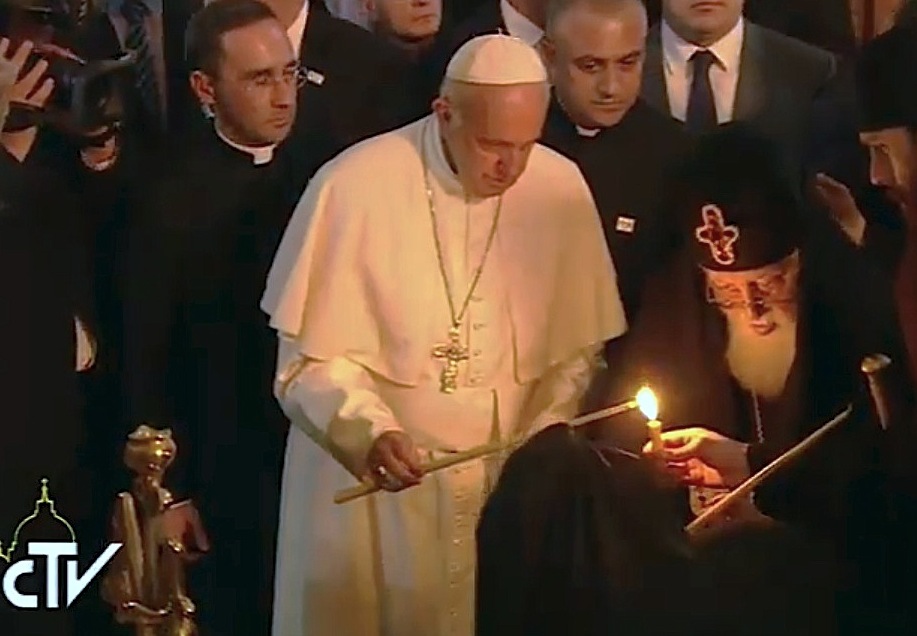Pope Francis wrapped up his visit to Georgia this evening with a plea for Christian unity.
The Pope visited the Svietyskhoveli Patriarchal Cathedral in the spiritual center of Georgia, at Mskheta, which is just some 12 miles north of the capital city of Tbilisi.
The Pope was greeted by His Holiness and Beatitude Ilia II, Catholicos Patriarch of All Georgia, who accompanied him to the shrine of St. Sidonia.
According to tradition, Sidonia was buried with the tunic Christ was wearing before the crucifixion — the one referenced in John 19 as being “without seam, woven from top to bottom,” for which the soldiers “cast lots for it to see whose it shall be.”
The Pope and the Patriarch placed two votive candles at the saint’s burial place.
Ilia II welcomed the Pope and spoke of the suffering of the Georgian people as well as the history of the tunic and St. Sidonia.
“Saint Sidonia belonged to a remarkable family of Georgian Jews: her brother Eliezer brought the Tunic to Georgia. Here, in the town of Mtskheta, their mother, devastated by the Saviour’s sufferings, on the day of His Crucifixion on Great Friday, died, and after her death, the Church of Georgia consecrated her also as a saint,” he said.
The Pope referenced the tunic in his call for unity.
“The mystery of the tunic, ‘without seam, woven from top to bottom’ (Jn 19:23), has attracted the attention of Christians from the beginning,” he said. “One of the early Church Fathers, Saint Cyprian of Carthage, declared that in the undivided tunic of Jesus there appears that ‘bond of concord inseparably cohering,’ that ‘unity which comes from above, that is, from heaven and from the Father, which could not be definitively rent’ (De Catholicae Ecclesiae Unitate, 7: SCh 1 [2006], 193).”
He said the tunic is a mystery of unity and it “exhorts us to feel deep pain over the historical divisions which have arisen among Christians: these are the true and real lacerations that wound the Lord’s flesh.”
But, Pope Francis said, the “unity which comes from above” urges us “to not give up but rather to offer ourselves as he did.”
The Bishop of Rome acknowledged that the work for unity “requires patience nurtured through trusting others and through humility, without fear and discouragement, but rather rejoicing in the certainty which Christian hope allows us to enjoy. This gives us the incentive to believe that differences can be healed and obstacles removed; it invites us never to miss opportunities for encounter and dialogue, and to protect and together improve what already exists. I am thinking, for example, of the current dialogue of the International Joint Commission and other propitious occasions for exchange.”
The Pope’s reference to the commission comes as the Georgian Orthodox Church was in disagreement with the accord reached by the group in September regarding primacy and synodality in the first millennium.
The Pope continued speaking about the significance of the tunic: “Saint Cyprian stated also that Christ’s tunic – “one, undivided, all in one piece, indicates the inseparable concord of our people, of us who have been clothed in Christ” (De Cath., 195). Those baptized in Christ, as Saint Paul teaches, have been clothed in Christ (cf. Gal 3:27). Thus, notwithstanding our limitations and quite apart from all successive cultural and historical distinctions, we are called to be “one in Christ Jesus” (Gal 3:28) and to avoid putting first disharmony and divisions between the baptized, because what unites us is much more than what divides us.”
—
ON ZENIT’s Web page:
Full text of Patriarch’s address: https://zenit.org/articles/ilia-iis-address-at-pope-francis-visit-to-patriarchal-cathedral/
Full text of Pope’s address: https://zenit.org/articles/popes-greeting-at-visit-to-patriarchal-cathedral-in-georgia/

Pope Refers to Christ’s Tunic in Plea for Christian Unity
Relic Buried in Georgia’s Patriarchal Cathedral Is Symbol of the Work Churches Must Do to Find Harmony


